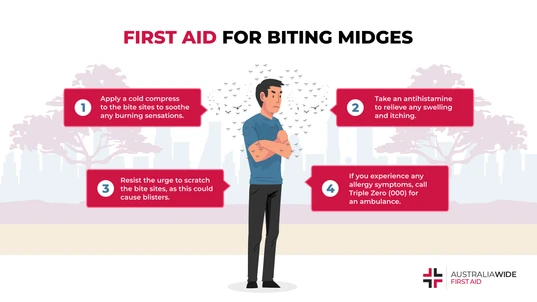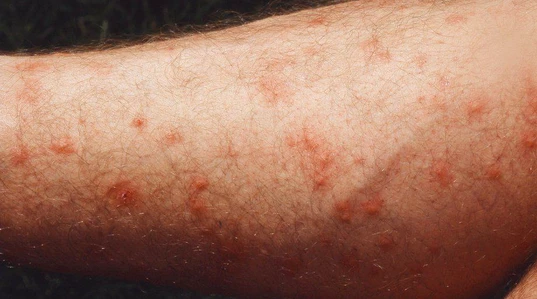Applying First Aid for Biting Midges

Bites and Stings

Interesting Facts about the Biting Midge
Only the female biting midge bites. She does this by breaking the victim’s skin and injecting saliva that prevents the blood from clotting. She then consumes enough protein from the blood to help develop a batch of eggs. This article reveals the details about the behaviour of the biting midge, its risk to humans, and the everyday precautions you can take when dealing with this tiny terror.Interesting facts about the Biting Midge
More than 200 varieties of midges can be found in Australia. The insect follows a holometabolous life cycle which comprises four life stages: the first as an as egg, the second as a larva, the third as a pupa, and the last as a mature adult. The average lifespan of an adult midge, depending on the individual species, is between a few days and several months. The biting midge grows to approximately 0.5 mm to 4 mm long – about size of a pinhead. Small though a biting midge may be, it often swarms with its peers to become a formidable pest. This class of minuscule flies, known in Australia as biting midges is called "no-see-ums" in America, and classified under the family Ceratopogonidae. Biting midges thrive in coastal habitats such as in the lagoons, estuaries, and mangrove swamps of Australia. They are particularly fond of making their homes in damp soil, damp beds of decaying leaf material, muddy and vegetated substrates, or tidal flats (hence the erroneous ascription of the alternative name “sandfly”). The moisture afforded by these environments makes a perfect hatching ground for their eggs. Temperature is an equally important condition to the biting midge; they are most active in humid weather that’s between 27°C and 32°C, and they avoid the windy weather. Midges rarely disperse very far from their breeding sites, and as such, most midge bites to humans happen near these conspicuous areas.
There is no documented case of a biting midge acting as a vector for disease-causing pathogens to humans.
How dangerous are midge bites to humans?
Some varieties of biting midge serve as vectors of deadly diseases to cattle, among them the blue tongue disease, African horse sickness, and epizootic haemorrhagic disease. There is no documented case of a biting midge acting as a vector for disease-causing pathogens to humans. All the same, the midge can inflict a bite that swells, blisters, or weeps with clear discharge. A bite can cause acute discomfort and irritation and, if scratched excessively and exposed to bacteria, it may become infected. In cases that are few in number but severe nonetheless, bites may trigger an allergic reaction and necessitate treatment for anaphylactic shock. Over time and repeated exposure, local residents will cease to be bothered by biting midges. Still, they may prove a nuisance to tourists or new inhabitants of a coastal area. Sound first aid practices and enough foresight on everyone’s part will keep your community free of midge bites.Treating and preventing midge bites
If you incur a bite from a biting midge, you should attend to it immediately in order to avoid complications. Basic first aid for midge bites can be completed in the following steps:- Apply cold compress, such as with an ice pack or a wet cloth, to soothe any burning sensation you feel on the bitten area.
- Take an antihistamine to relieve the swelling and itching. Prior to your encounters with biting midges or other pesky insects, you should have these medicines readily available in your own DIY first aid kit.
- Resist the urge to scratch the affected area, lest you incur a blister, a welt, or an infected wound that persists for days and will require additional medical attention. Your doctor may prescribe antibiotics or an antiseptic cream to mitigate the infection.
- If you experience any symptoms that may indicate an allergic reaction, call Triple Zero (000). Don’t delay in enlisting professional medical help to follow through on your anaphylaxis plan.
The prevention of midge bites is better than trying to cure them. Actively avoiding midge-infested sites serves practical, as well as ecological purposes: as of this time, there is no chemical registered in Australia that can keep entire midge populations at bay, and excessive usage of pesticide may prove harmful for other species in the environment. Australia Wide First Aid recommends taking the following precautions:
- Avoid going outdoors at dawn or at dusk, as midge bites occur most frequently during these periods in the day.
- Don’t go about watering your plants at sunset, as the midges may be lurking under the cool and humid shade of your trees.
- Don protective clothing such as long-sleeved shirts with collars, trousers, and closed-toed shoes with socks when you go out in the early morning or late evening.
- Apply insect repellent formulated with 15% to 20% diethyltoluamide (DEET), focusing on sensitive areas such as your scalp, neck, and ankles. This will ward off midges as well as mosquitoes, ticks, and other biting bugs.
- Make sure you have good air circulation indoors; a competent ceiling or pedestal fan will suffice. Midges dislike the strong breeze and will stay away from it.
- Pay attention to the local news about any discovered breeding sites or occurrences of midge outbreak. If you’re suddenly on the receiving end of a midge-related disturbance, ask for help from a pest control operator or from your local government.
Learn about first aid treatment for insect bites
Bites and stings from midges, as with bites and stings from other Australian insects and arachnids, can be not only unpleasant but, considering anaphylaxis, also dangerous. However, many such bites and stings are both treatable and easily preventable. You can learn from the experts and gain considerable mastery over insect bites, anaphylaxis management, and other related first aid technique at an Australia Wide First Aid course.
Originally published at
https://www.australiawidefirstaid.com.au/resources/biting-midges
as part of the Australia Wide First Aid Articles Library









